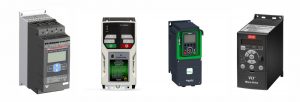If you missed the first edition click here.
BS EN 60269-4/BS 88-4 Low-voltage, High-Speed Fuses for Semiconductor Devices
High-speed fuses are thermal, current-controlled devices utilised for protecting semiconductor electrical circuits from short-circuits. Featuring a specially designed element profile and construction that offers all the necessary characteristics required for the protection of semiconductor devices. These characteristics include low energy let-through (l2t), low peak currents (lPEAK), low arc voltage and high-heat dissipation.

Typical devices requiring semiconductor protection
This type of fuse consists of one or more current-carrying elements enclosed within a chamber which is typically made of glass-melamine or ceramic. This chamber is fitted with terminals that allow the fuse to be inserted or removed easily from an electrical circuit. High-speed fuses don’t have any intentional time-delay features like those found in general industrial fuses and can be placed into two categories: full range high-speed fuses and partial range high-speed fuses.
Full Range High-Speed Fuses: These fuses offer protection to both overload and short-circuit overcurrent conditions and have the category symbol gR. The first letter ‘g’ denotes full range protection while the second letter ‘R’ denotes semiconductor device application.
Partial Range High-Speed Fuses: This variant of fuse offers protection to short-circuit overcurrent condition and have the category symbol aR. The first letter “a” denotes partial range protection and the ‘R’ denotes semiconductor device application.
Typical applications for ‘aR’ or ‘gR’ variant fuses include; the protection of semiconductors such as diodes, thyristors, triacs and other similar devices that are found in power rectifiers, UPS, converters, AC and DC motor drives, soft starters, solid-state relays, photovoltaic inverters, welding inverters and many other applications where it is necessary to protect semiconductor devices.

High-speed fuses have a unique design intentionally applied to help prevent their misapplication in other general industrial applications in the field. Their classification is based on their dimension, mounting, and origin and can be found in a variety style including North American Traditional Round Body, Square Body – such as the 170M, Cylindrical or Ferrule and British Standard (BS88) Bolted.
View our range of Semiconductor protection fuses
Medium Voltage Fuses
A medium voltage (MV) fuse is utilised differently to other fuses that are rated at 600 Volts and below, the main difference is that medium voltage fuses are not intended to provide overload protection. MV fuses are typically only applied where the fuse will not be required to open as a result of a small overcurrent. When correctly installed MV fuses are intended to carry their nominal current rating continuously without failure fatigue, meaning the fuse will not age or deteriorate even under intensive duty cycles.

Medium voltage fuses are available in two basic variants:
- Expulsion Fuse. This is a vented fuse where the expulsion effect of the gases produced by internal arcing, results in current interruption. Expulsion fuses will limit the duration of an overcurrent, but not limit the magnitude of fault current.
- Current Limiting Fuse. When in this fuse’s element is melted by a current within the fuse’s specified current-limiting range, it abruptly introduces a high resistance to reduce current magnitude and duration, resulting in a current interruption. Applications for current-limiting fuses includes the protection of feeders, transformers and motor circuits designed to ANSI, BS, DIN and IEC standards.
Current limiting fuses are further classified into three categories:
- Full Range. These fuses are capable of interrupting all currents from the maximum rated interrupting current down to the minimum continuous current that caused the melting of the fusible element.
- General Purpose: Designed to interrupt all currents from the maximum rated interrupting current down to the current that causes the melting of the fusible element in one hour.
- Back-up: A fuse capable of interrupting all currents from the maximum interrupting rating current down to the minimum interrupting current. The minimum interrupting current is the lowest current that the fuse will be able to clear properly.
MV fuses Typically fall into E-Rated and R-Rated Variants.
- E-Rated fuses are used to protect feeder circuits, power transformers, voltage switches, potential transformers and have defined current response times.
- R-Rated fuses are back-up fuses that provide short-circuit protection for motor circuits and are applied with MV motor starters, providing overload protection for the circuit.

Boric Acid Fuse
Typical Medium Voltage fuse types variants include:
- DIN – IEC fuses – DIN 43625 specified current-limiting fuses for transformer protection
- Potential Transformer fuses – British standard VT fuses with a low current rating for use in voltage transformers providing isolation of the electrical system.
- British Standard – IEC Fuses for use in Oil Filled Distribution Switchgear – used in 3 phase 50Hz transformers in oil field switchgear.
- Fast-Acting Fuses – space-saving fast-acting fuses, non-time delay ideal for instrument protection.
- BBU Boric Acid Fuses – suitable for power transformers, feeder circuits, metal-enclosed and Pad-mounted switchgear
Look out for the final part of this series.
Don’t forget to read these articles!
Industry 4.0 – Back Bone of Industry

Kempston Controls is committed to finding you the ideal solution for your application. Call us today on +44 (0) 1933 411 411, email us at sales@kempstoncontrols.co.uk, or alternatively contact us here, we will be happy to help.

